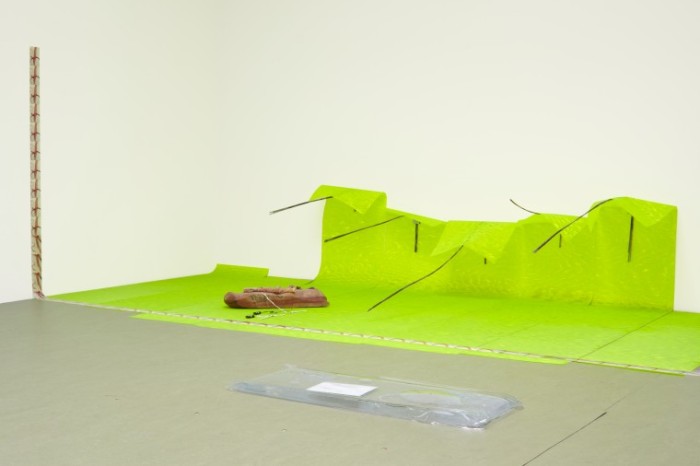
The press release for “On The Brink Of My Sexy Apocalypse”, Olga Balema’s sensuous Los Angeles gallery debut, offers little more than an anecdotal excerpt from Jean Genet’s novel Our Lady of The Flowers (1943). While this sliver of the author’s gorgeous prose beguilingly portends the artist’s preoccupation with fluidity, the show’s title is more telling. Given the importance of liminal ruminations to Balema’s practice, it is fitting that notions of porousness and entropy fluctuate throughout her environmental installation.
Central to this trifurcated exhibition is a large room, its flooring covered with pale green linoleum, displaying several low-lying sculptures, including four mattress-like, PVC bags filled with water in which sundry items of steel, fabric, and paper are hermetically sealed. These works set in motion a course of invisible yet inevitable decay. It’s hard not to consider them as bodies; their internalized systems enacting digestion, absorption, and decomposition. Nestled nearby within a larger Day-Glo installation is the uncanny A thing filled with evil streams (2016), an oblong wooden block apparently supporting a partial ribcage replete with vertebrae. A battery-operated cell phone motor vibrates within a niche in the sculpture’s thorax, as if it were on life support.
The accompanying spaces further this current of corporeal allusion through several loose sculptures comprised of fabric, latex, and steel. These skeletal works exude a poetic force more sensual than logical, though not without their own intelligences. Like all the other pieces in this materially thrilling installation, these works don’t so much occupy space as invade it, as a parasite might attach to a host. And what has penetrated a surface must ultimately affect its interior.
–
Image: Olga Balema, On The Brink Of My Sexy Apocalypse (Installation view) Image courtesy of the artist and Hannah Hoffman.
Originally published by Flash Art, Vol. 49, No. 314 (May 2017), pp. 94-95.